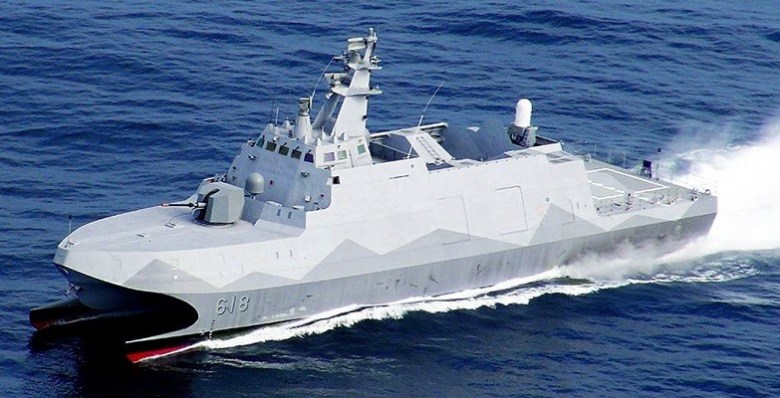Taiwan plans to build a new fleet of anti-submarine corvettes to hunt down Chinese submarines, a move that threatens to escalate already high and rising tensions around the self-governing island Beijing considers a renegade province.
Taiwan’s Minister of National Defense, Chiu Kuo-cheng, announced this week that the island’s armed forces are prioritizing the anti-submarine ships to protect against a possible Chinese blockade, for which Beijing signaled the capacity and intent during provocative military operations in August, Taipei Times reported.
Based on previous People’s Liberation Army (PLA) wars and attack scenarios, the key to defending the island will be protecting its airfields and ports to keep commercial traffic as safe and open as possible, the Taipei Times report said.
If Taiwan’s ports are open and the US can deliver military aid, any confrontation will become a de facto clash between the US and China, which from Taiwan’s perspective is its best deterrent option.
China’s submarine fleet would likely be its workhorse in enforcing a Taiwan blockade. This August, Asia Times reported that China’s advanced Type 39 C/D and other conventional submarines would likely be the backbone of any such operation that targeted ships entering and leaving Taiwan’s ports.
Submarines are ideal blockade enforcers as they can achieve strategic effects such as potential capitulation with their mere presence. Moreover, their battle losses and mission failures can more easily be concealed from the public.
Given that, the Taipei Times report states that keeping China’s submarines at a distance to secure Taiwan’s ports is critical, making advanced anti-submarine ships are a must. Moreover, in peacetime, the corvettes could be used for reconnaissance and surveillance along the Taiwan Strait.
However, the same news report notes that Taiwan has little experience building such surface combatants, which will require building a prototype that is refined through technology and other expertise.

The indigenous construction plan comes after Taiwan recently balked at acquiring US-made anti-submarine helicopters due to their high cost. In May, Reuters reported that Taiwan abandoned a plan to acquire 12 MH-60R anti-submarine helicopters, with Chiu stating at the time that the price was too high and beyond the scope of Taiwan’s budget.
Although the US is Taiwan’s traditional military supplier, the opposition Kuomintang Party criticized US weapons as overpriced for less advanced and obsolete systems. It also said that the US is concerned only about profiteering and not Taiwan’s real defense needs.
At the same time, the Kuomintang advocated diversifying Taiwan’s military suppliers and emphasized public-private cooperation to improve its domestic defense industry.
Washington and Taipei’s perception of a narrowing window before a Chinese military attempt at “reunifying” Taiwan with the mainland has prompted both sides to act with greater urgency.
This month, The New York Times reported that the US is intensifying efforts to turn Taiwan into a giant weapons depot, enabling the self-governing island to hold out against an attempted invasion until US assistance arrives.
However, the report notes that the US and its allies have prioritized sending weapons to Ukraine and that arms manufacturers are reluctant to open new production lines without a steady stream of orders.
On this theme, Taipei Times reported that Chiu mentioned possible collaboration between Taiwan’s Ministry of National Defense and civilian defense forces. However, the source notes that conducting the required loyalty checks and ensuring advisory controls for all participants would be difficult.
Taiwan faces serious espionage concerns, with its government and military already known to be extensively penetrated by Chinese spies and intelligence agencies. Last December, Reuters reported on China’s extensive penetration of Taiwan’s military, involving high-ranking officers and even the security detail of Taiwanese President Tsai Ing-wen.
Moreover, the Reuters report said that China’s spies can provide information on Taiwan’s troop locations and weapons sites. Disloyal officers could refuse to fight, misdirect their troops or even induce them to defect to China’s side, the report said.
In addition, the US longstanding policy of “strategic ambiguity” may have cast doubts among Taiwanese leaders and defense planners about Washington’s commitment if push comes to shove.
Even so, President Tsai has struck a defiant tone, saying that Taiwan will not rely on others for its defense while acknowledging the US for its commitment to Taiwan’s security and weaponry, as reported by Reuters this month.

Tsai’s remarks may find practical application in Taiwan’s indigenous defense industry, which aims to reduce the self-governing island’s reliance on US military aid and security guarantees. Asia Times has reported on several critical Taiwanese indigenous defense projects, including submarines, missiles, drones, and amphibious assault ships.
These projects vary in ambition and technical sophistication, ranging from requiring substantial foreign assistance, such as its submarine program, to within Taiwan’s existing industrial capacity, such as its amphibious assault ship program. Taiwan’s drones and missiles also leverage its strengths in semiconductors, microchips and electronics.
A small fleet of advanced anti-submarine corvettes may thus be well within Taiwan’s industrial and technological capabilities. Taiwan currently operates 11 Ching Chiang and two more modern Tuo Chiang class stealth corvettes.
In line with expanding its corvette force, Taiwan News reported last month that Taiwan’s Ministry of National Defense unveiled plans to build ten more Tuo Chiang stealth corvettes to strengthen its asymmetric warfare capabilities. The source noted the prototype ship and namesake of the class, Tuo Chiang, was completed in 2014, while Taiwan launched the Ta Chiang in 2020.
The ships are optimized for surface warfare, armed with Hsiung Feng II and III anti-ship missiles, Sea Sword surface-to-air missiles, a 76 mm Otobreda gun, a T-74 7.62 mm machine gun, and a Phalanx close-in weapons system.
The class sports a stealthy superstructure shape and catamaran hull that enables high speed in rough seas, with a 40 knots maximum speed, 685-ton displacement and 1,800 nautical mile operational range.
Given Taiwan’s decision to procure more Tuo Chiang stealth corvettes, it may optimize upcoming models for anti-submarine warfare.

